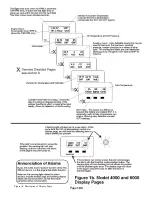
Page
115
Crimp the mating connectors onto the extension wire. Plug the color-coded leads onto the matching
color extension wires. Secure the probe leads with suitable wire clamps to prevent them from chaffing
against the engine or airframe. Heat shrink tubing can be used to protect the leads from abrasion, and
insulate the electrical connections to the probe.
NOTE :
The length of wire on the EGT & CHT probes, or the extension wire may be shortened as
desired for your installation.
5.3
Verify the Wiring – A Quick Check
Take a moment now to review all wiring connections you have made to the EIS. Double check the
following wiring:
a) power
b) ground
c) tachometer connections
d) Verify that the same ground wire is not used as both a ground to the engine for the EIS, and as a
ground for the ignition kill switches. Verify that these separate ground leads do not connect to the
engine in such a way that they could be become disconnected from the engine, but remain connected
together. Do not use the same connection to the engine for these ground leads.
Finally, install the connector backshell using the supplied hardware. Secure the wiring, using cable
clamps to the aircraft structure so that no strain is transmitted to the connector. Plug the connectors
into the EIS and secure them to the instrument with the screws included with the back shell.
6.
Check-Out
6.1
Initial Application of Power to the Instrument
Apply power to the system Verify that the LCD display becomes active. The instrument will be on
display page 0. If this operation is not observed, immediately turn off power to the EIS and recheck all
wiring---especially power, ground, 4.8V excitation output and 12V fuel flow power output.
At this point, you may wish to completely configure the instrument for your installation. Refer the
section “Configuring the EIS for your Installation”.
6.2
Tachometer Initial Test
Turn on the EIS. The tachometer will display 0 when the engine is not operating. Refer to the
“Configuration Set Pages” section, and set the TachP/R according to the type of engine you have.
Turn off the EIS. Start the engine; turn on the EIS and verify that the tachometer reading is active and
appears reasonable.
6.2.1
Testing Tachometer Inputs
Two inputs are provided for the tachometer sensing. The EIS will use tachometer input 1 when a
tachometer signal is sensed. If tachometer input #1 is not providing any RPM indication, the EIS will
use the tachometer input #2. Each input must be tested to make sure it is functioning. This test is
accomplished by turning off tachometer input #1 (such as by turning off the magneto), and observing
is tachometer input #2 provides an accurate and stable tachometer reading. Repeat this by turning off
the tachometer input #2 and verifying the tachometer input #1 is accurate and stable.
Summary of Contents for 912 Dragonfly
Page 3: ...Page 2 ...
Page 4: ...Page 3 ...
Page 5: ...Page 4 ...
Page 25: ...Page 24 Drawing 1 ...
Page 27: ...Page 26 Drawing 2 ...
Page 29: ...Page 28 Drawing 3 ...
Page 31: ...Page 30 Drawing 4 ...
Page 33: ...Page 32 Drawing 5 ...
Page 35: ...Page 34 Drawing 6 ...
Page 37: ...Page 36 Note for Hydraulic Brakes see Appendix B Drawing 7 ...
Page 39: ...Page 38 Drawing 8 ...
Page 41: ...Page 40 Drawing 9 ...
Page 43: ...Page 42 Drawing 10 ...
Page 45: ...Page 44 Drawing 11 ...
Page 47: ...Page 46 Drawings 12A 12B ...
Page 49: ...Page 48 Drawing 13 ...
Page 51: ...Page 50 Drawing 14 ...
Page 53: ...Page 52 Drawing 15 ...
Page 55: ...Page 54 Drawing 16 ...
Page 57: ...Page 56 Drawing 17 ...
Page 59: ...Page 58 Drawing 18 ...
Page 61: ...Page 60 Drawing 19 ...
Page 63: ...Page 62 Drawing 20 ...
Page 65: ...Page 64 Drawing 21 ...
Page 67: ...Page 66 Drawing 22 ...
Page 69: ...Page 68 Drawing 23 ...
Page 71: ...Page 70 Drawing 24 ...
Page 73: ...Page 72 Drawing 25 ...
Page 75: ...Page 74 Drawing 26 ...
Page 77: ...Page 76 Drawing 27 ...
Page 79: ...Page 78 Wiring1 jpg Drawing 28a ...
Page 80: ...Page 79 Wiring2 jpg Drawing 28b ...
Page 81: ...Page 80 elecLights jpg Drawing 28c ...
Page 83: ...Page 82 Drawing 29 ...
Page 85: ...Page 84 Drawing 30 ...
Page 92: ...Page 91 Appendix B Brakes Manual for BX1320 BX1000 Appendix B Page 1 ...
Page 93: ...Page 92 Appendix B Page 2 ...
Page 94: ...Page 93 Appendix B Page 3 ...
Page 96: ...Page 95 Appendix B Page 5 ...
Page 97: ...Page 96 Appendix B Page 6 ...
Page 98: ...Page 97 Appendix B Page 7 ...
Page 104: ...Page 103 Figure 1a Description of Display Pages ...
Page 105: ...Page 104 Figure 1b Description of Display Pages ...
Page 138: ...Page 137 Appendix C EIS 4000 912 914 ...
Page 139: ...Page 138 Appendix C EIS 4000 912 914 ...
Page 140: ...Page 139 Appendix C EIS 4000 912 914 ...
Page 141: ...Page 140 Appendix C EIS 4000 912 914 End Appendix C ...
Page 155: ...Page 154 Appendix E2 Powerfin Prop Page 2 ...
Page 156: ...Page 155 Appendix E2 Powerfin Prop Page 3 ...
Page 157: ...Page 156 Appendix E2 Powerfin Prop Page 4 ...
Page 158: ...Page 157 Appendix E2 Powerfin Prop Page 5 ...
Page 159: ...Page 158 Appendix E2 Powerfin Prop Page 6 ...
Page 160: ...Page 159 Appendix E2 Powerfin Prop Page 7 ...
Page 161: ...Page 160 Appendix E2 Powerfin Prop Page 8 ...
Page 162: ...Page 161 Appendix E2 Powerfin Prop Page 9 ...
Page 163: ...Page 162 Appendix E2 Powerfin Prop Page 10 ...
Page 164: ...Page 163 Appendix E2 Powerfin Prop Page 11 End of Appendix E2 ...
Page 187: ...Page 186 By Memphis Soaring FIGURE 3 Common Signals ...














































